Betnesol N Eye/Ear Drops 5 ml
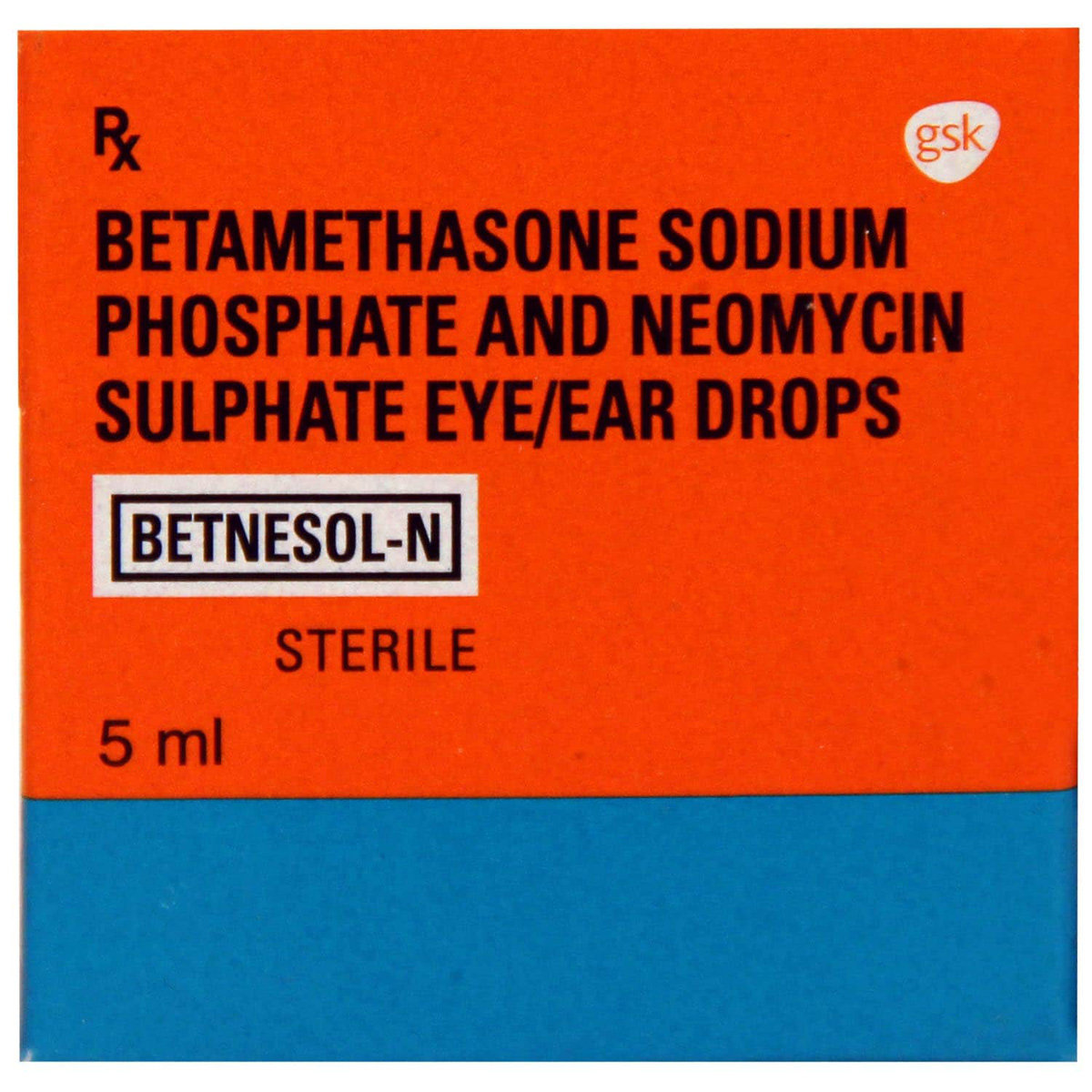
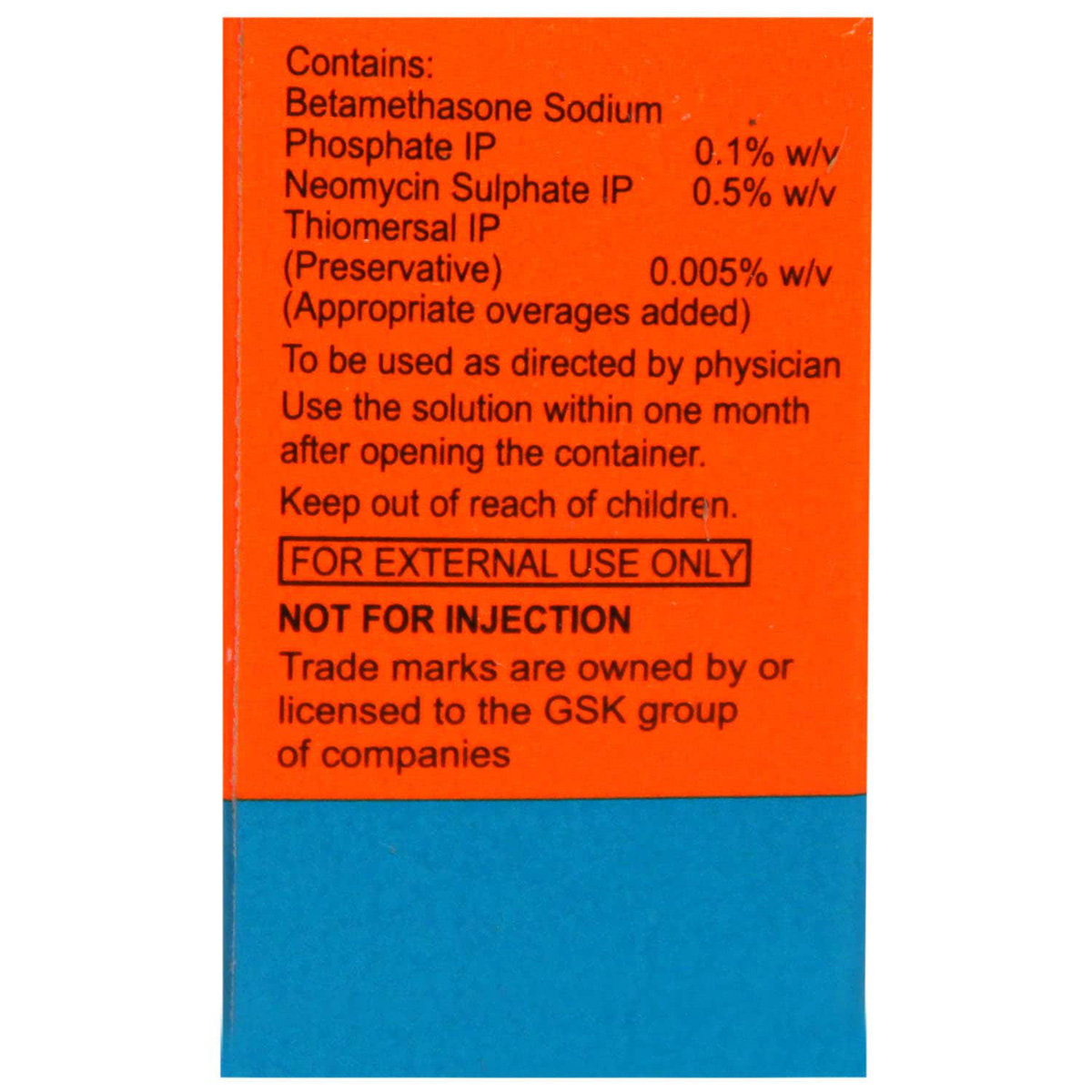
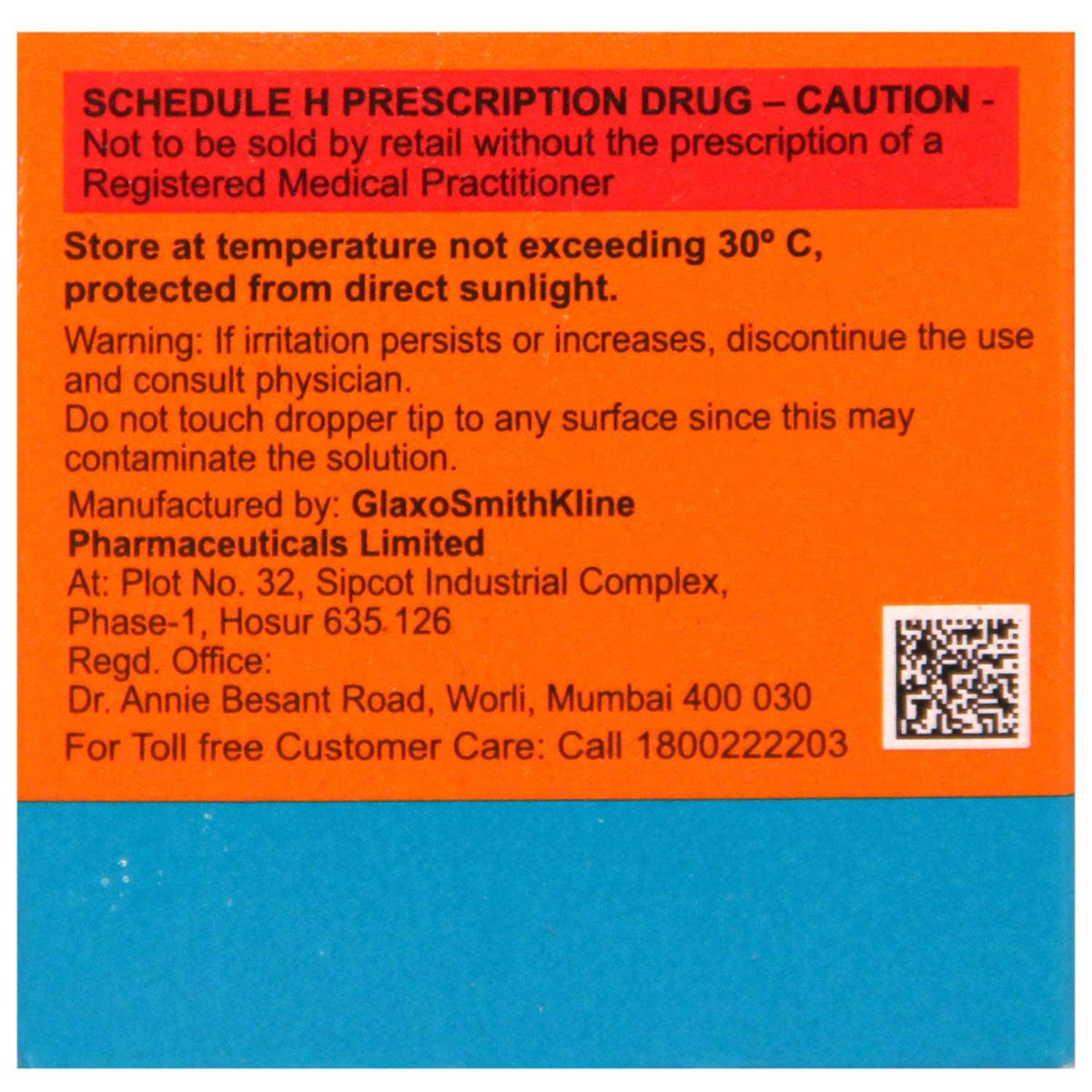
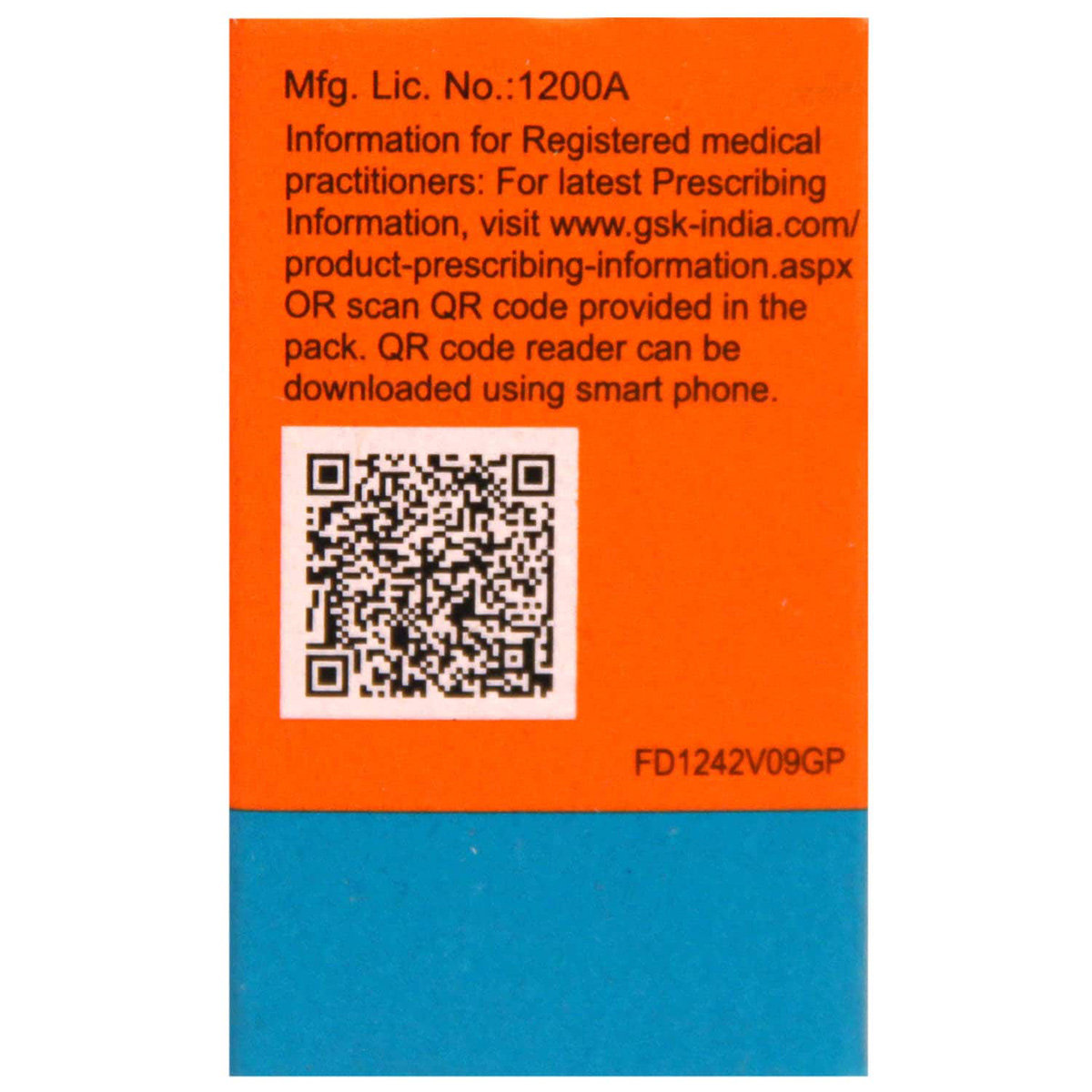
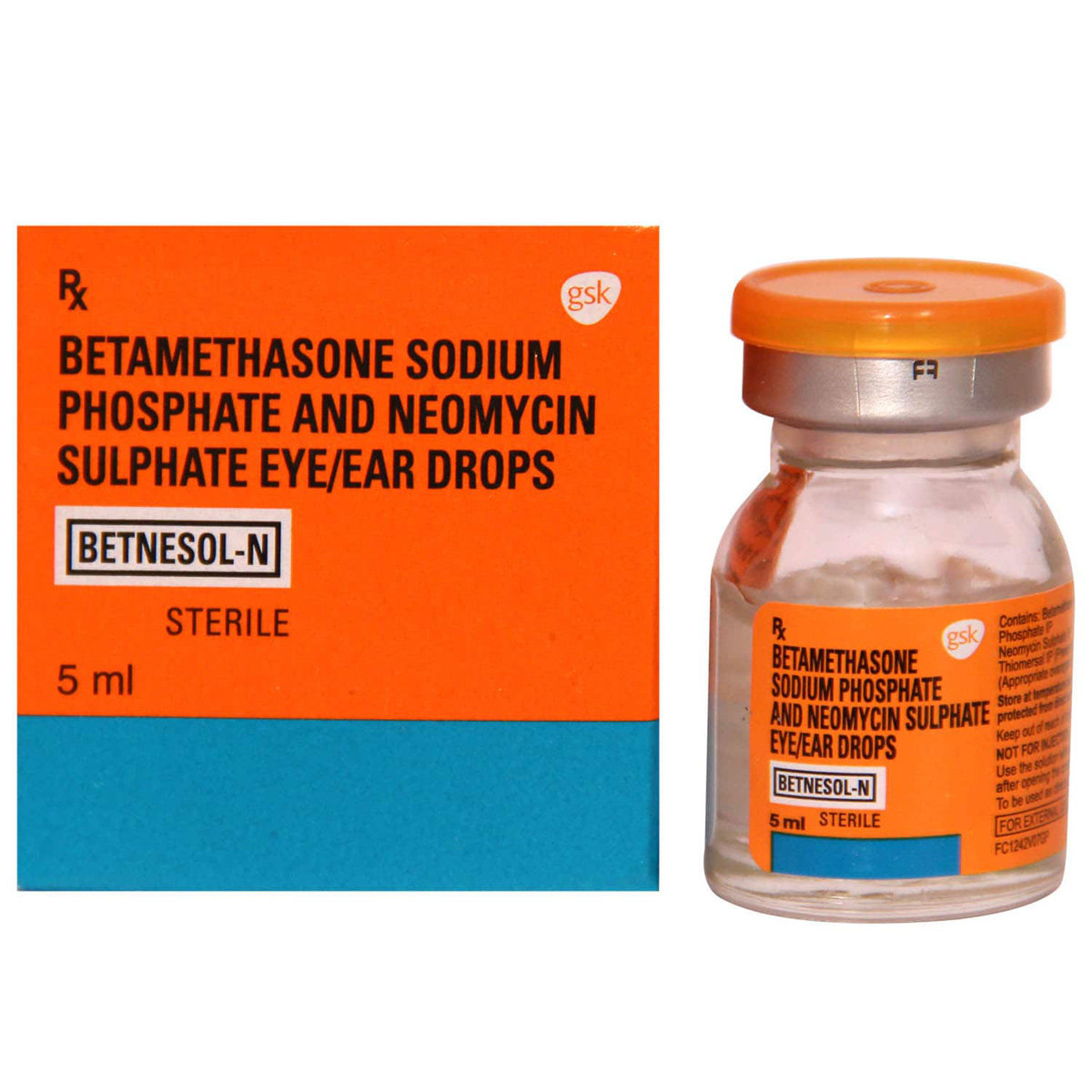





MRP ₹22.5
(Inclusive of all Taxes)
₹3.4 Cashback (15%)
Provide Delivery Location
Online payment accepted
 Prescription drug
Prescription drugWhats That
Composition :
Manufacturer/Marketer :
Consume Type :
Return Policy :
Expires on or after :
About Betnesol N Eye/Ear Drops 5 ml
Betnesol N Eye/Ear Drops 5 ml is a combination medicine used to treat bacterial infections of the eye and ear like allergic conjunctivitis (inflammation of the mucous membrane (conjunctiva) of the eye), uveitis (inflammation of the uvea-middle layer of the eye), marginal keratitis (inflammation of the cornea), blepharitis (inflammation of the eyelids), and otitis externa (inflammation of the ear). Betnesol N Eye/Ear Drops 5 ml may also be used to treat steroid-responsive inflammation of the ear and nose.
Betnesol N Eye/Ear Drops 5 ml is composed of two medicines: Betamethasone and Neomycin. Betamethasone belongs to the class of corticosteroids. It blocks the production of prostaglandins (chemical messengers) that make the affected area red, swollen and itchy. Neomycin is an aminoglycoside antibiotic that prevents bacteria from synthesising essential proteins required to carry out vital functions. It has broad-spectrum activity against aerobic gram-positive and gram-negative bacteria.
Your doctor will advise the appropriate dose that suits your infection. Betnesol N Eye/Ear Drops 5 ml is for external use only. Common side effects of Betnesol N Eye/Ear Drops 5 ml include irritation, itching, redness, burning or a stinging sensation at the application site. Most of these side effects do not require medical attention and gradually resolve over time. However, if the side effects persist or worsen, consult a doctor.
Let your doctor know if you are sensitive to Betnesol N Eye/Ear Drops 5 ml or any other medications. Please inform your doctor if you have any undiagnosed red eye, pulmonary tuberculosis, hearing problems (ototoxicity) and a perforated eardrum before using Betnesol N Eye/Ear Drops 5 ml. Pregnant and breastfeeding mothers should consult the doctor before starting Betnesol N Eye/Ear Drops 5 ml. Betnesol N Eye/Ear Drops 5 ml should be used in children only when advised by a doctor, and their growth should be closely monitored since there are chances of delay in growth.
Uses of Betnesol N Eye/Ear Drops 5 ml
Directions for Use
Medicinal Benefits
Betnesol N Eye/Ear Drops 5 ml treats various bacterial infections like allergic conjunctivitis (inflammation of the mucous membrane (conjunctiva) of the eye), uveitis inflammation of the uvea (middle layer of the eye), marginal keratitis (inflammation of the cornea), blepharitis (inflammation of the eyelids), and otitis externa (inflammation of the ear). It may also be used to treat steroid-responsive inflammation of the ear and nose. Betnesol N Eye/Ear Drops 5 ml consists of Betamethasone (corticosteroid) and Neomycin (antibiotic). Betamethasone blocks prostaglandins production (chemical messengers) that make the affected area red, swollen, and itchy. Neomycin prevents the synthesis of essential proteins required by bacteria to carry out vital functions.
Storage
- Eat a healthy, well-balanced diet full of vitamins, minerals, and omega-3 fatty acids to help maintain eye health.
- Wear UV-protecting sunglasses when you are outside or in bright light.
- Avoid touching or rubbing your eyes it may increase irritation.
- Seek medical care if you are experiencing extreme eye pain or discomfort.
- To the affected part, apply warm compresses to get a temporary relief.
- Rinse your eye carefully with clean water and try to blow any dust particle that could have entered.
- Take over the counter medication to lubricate your eye or if there is pain due to allergy to soothe the eye.
- If there is persistent pain in your eye, consult your doctor and follow the medication immediately.
- Talk to the doctor if you notice any visual disturbances.
- Do not drive or operate machinery unless you have a clear vision.
- Lubricate the eyes and use a warm compress to gently massage the eyes.
- Keep your eyes protected from harmful sun rays by wearing sunglasses and a hat.
- Rest well and eat a balanced diet.
- Use a humidifier and increase fluid intake.
Drug Warnings
Before taking Betnesol N Eye/Ear Drops 5 ml, let your doctor know if you have a history of eye problems (glaucoma and cataract), heart, liver, or kidney diseases, undiagnosed red eye, pulmonary tuberculosis, hearing problems (ototoxicity) or a perforated eardrum. Avoid touching the dropper with bare hands since it contaminates the dropper tip and solution. If you wear contact lenses, please inform your doctor since eye drops may contain additives like Benzalkonium chloride that change the colour of the lens. It is advised to check with your doctor before using Betnesol N Eye/Ear Drops 5 ml if you are pregnant or breastfeeding. Betnesol N Eye/Ear Drops 5 ml should be used in children only when advised by a doctor.
Drug-Drug Interactions
Drug-Drug Interactions
Login/Sign Up
Co-administration of Betnesol N Eye/Ear Drops 5 ml with Mifepristone may significantly reduce the effect of Betnesol N Eye/Ear Drops 5 ml which may be less effective as a therapy.
How to manage the interaction:
Taking Betnesol N Eye/Ear Drops 5 ml with mifepristone together can result in an interaction, it can be taken if a doctor has advised it. Contact a doctor immediately if you experience any unusual symptoms. Do not discontinue any medications without consulting a doctor.
Co-administration of Iomeprol and Betnesol N Eye/Ear Drops 5 ml can increase the risk of seizures.
How to manage the interaction:
Taking Betnesol N Eye/Ear Drops 5 ml with Iomeprol is not recommended, please consult your doctor before taking it.
Co-administration of Iohexol and Betnesol N Eye/Ear Drops 5 ml can increase the risk of seizures.
How to manage the interaction:
Taking Betnesol N Eye/Ear Drops 5 ml with Iohexol is not recommended, please consult your doctor before taking it.
Co-administration of Iopamidol and Betnesol N Eye/Ear Drops 5 ml can increase the risk of seizure.
How to manage the interaction:
Taking Betnesol N Eye/Ear Drops 5 ml with Iopamidol is not recommended, please consult your doctor before taking it.
Co-administration of Metrizamide and Betnesol N Eye/Ear Drops 5 ml can increase the risk of seizure.
How to manage the interaction:
Taking Betnesol N Eye/Ear Drops 5 ml with Metrizamide is not recommended, please consult your doctor before taking it.
Co-administration of Desmopressin with Betnesol N Eye/Ear Drops 5 ml can increase the risk of hyponatremia (low levels of salt in the blood).
How to manage the interaction:
Co-administration of Betnesol N Eye/Ear Drops 5 ml and Desmopressin can lead to an interaction, it can be taken if advised by a doctor. However, if you experience any symptoms like loss of appetite, nausea, vomiting, headache, lethargy, irritability, difficulty concentrating, memory impairment, confusion, muscle spasm, weakness, unsteadiness, decreased urination, and/or sudden weight gain, consult a doctor immediately. Do not stop using any medications without a doctor's advice.
Co-administration of Betnesol N Eye/Ear Drops 5 ml with Dinutuximab can increase the risk or severity of serious infections.
How to manage the interaction:
Taking Betnesol N Eye/Ear Drops 5 ml with Dinutuximab together can possibly result in an interaction, but it can be taken if a doctor has advised it. If you have any of these symptoms - like fever, chills, diarrhea, sore throat, muscle aches, shortness of breath, weight loss, pain, or burning during urination - make sure to contact a doctor right away. Do not discontinue any medications without consulting a doctor.
Co-administration of Vigabatrin with Betnesol N Eye/Ear Drops 5 ml may increase the risk of serious side effects associated with vision loss, especially if used together for prolonged periods.
How to manage the interaction:
Although there is an interaction, Betnesol N Eye/Ear Drops 5 ml can be taken with vigabatrin if prescribed by the doctor. Routine vision testing is advised during treatment with vigabatrin. Do not discontinue any medications without a doctor's advice.
Co-administration of Betnesol N Eye/Ear Drops 5 ml with Bupropion may increase the risk of seizures associated with Bupropion.
How to manage the interaction:
Although there is an interaction, Betnesol N Eye/Ear Drops 5 ml can be taken with Bupropion if prescribed by the doctor. Do not discontinue any medication without consulting a doctor.
Co-administration of Lomefloxacin may cause tendinitis (inflammation of the muscle to bone) and tendon rupture (injuries to the soft tissues that connect muscles and joints), and the risk may be increased when combined with Betnesol N Eye/Ear Drops 5 ml.
How to manage the interaction:
Although there is an interaction, Betnesol N Eye/Ear Drops 5 ml can be taken with Lomefloxacin if prescribed by the doctor. Consult the prescriber if you experience pain, inflammation, or swelling of a tendon area such as the back of the ankle, biceps, shoulder, hand, or thumb. Do not discontinue the medication without consulting a doctor.
Drug-Food Interactions
Drug-Food Interactions
Login/Sign Up
Diet & Lifestyle Advise
- Manage stress, eat healthily, drink plenty of water, exercise regularly, and get plenty of sleep.
- Eat food rich in antioxidants such as berries, spinach, kidney beans, dark chocolate, etc.
- Know your allergy triggers, such as pollen, dust and other factors.
- Avoid getting things like shampoo, soap, and water into the ear as it can cause itching.
- Do not poke or scratch the ear as it can cause damage to the ear canal, leading to inflammation.
- Do not rub your eyes even though some ophthalmic drugs make your eye itchy.
- If you wear contact lenses, clean and replace contact lenses more often. Never share contact lenses. Always remember to wash your hands before inserting and after removing the contact lens.
- Avoid staring at the digital screens for longer durations. Rest your eyes every 20 minutes.
- Avoid or limit the intake of alcohol and caffeine.
Side Effects of Betnesol N Eye/Ear Drops 5 ml
Eye drops:
- Irritation
- Itching
- Redness
- Burning or a stinging sensation
- Blurred vision
- Drooping eyelids
Ear drops:
- Ringing or buzzing in the ears
- Itching
Nasal drops:
- Headache
- Dry or blocked nose
- Irritation
- Sneezing
- Smell or taste changes
- Dizziness
Habit Forming
Therapeutic Class
All Substitutes & Brand Comparisons
RX
Out of StockBenicort N Eye/Ear Drops
₹9.18
(₹1.65/ 1ml)
59% CHEAPERRX
Out of StockBeta N Eye/Ear Drops
Oscar Remedies Pvt Ltd
₹10.95
(₹1.97/ 1ml)
51% CHEAPERRX
Out of StockBetaeno Eye/Ear Drops
₹12
(₹2.16/ 1ml)
46% CHEAPER
Product Substitutes
Author Details
We provide you with authentic, trustworthy and relevant information
Drug-Diseases Interactions
Drug-Diseases Interactions
Login/Sign Up
FAQs
Betnesol N Eye/Ear Drops 5 ml consists of Neomycin and Betamethasone. Neomycin is an antibiotic that prevents the synthesis of essential proteins required by bacteria to carry out vital functions. Betamethasone, a corticosteroid, works by blocking prostaglandins production (chemical messengers) that make the affected area red, swollen and itchy.
If you are wearing contact lenses, it is advised to remove them while administering eye drops. Also, remember to wash your hands before and after administering eye drops to avoid contamination.
If you use other eye ointments/drops along with Betnesol N Eye/Ear Drops 5 ml, it is advised to maintain a gap of at least 5-10 minutes after each administration. Also, use eye drops before applying any ointments.
Please inform your doctor before using Betnesol N Eye/Ear Drops 5 ml if you have undiagnosed red eye, pulmonary tuberculosis, hearing problems (ototoxicity) and a perforated eardrum. Betnesol N Eye/Ear Drops 5 ml is not recommended in viral, fungal, ocular (eye) tuberculosis, purulent (pus discharge) conditions of the eye, glaucoma, and herpetic keratitis (infection of the cornea).
Apply the drops as soon as possible. However, if it is time for the next dose, skip the missed dose and return to your regular dosing schedule.
Drug-Drug Interactions Checker List
- RITONAVIR
- COBICISTAT
Special Advise
It is advised to contact your doctor if the infection symptoms persist or worsen after two weeks of treatment.
Disease/Condition Glossary
Bacterial eye infection: A bacterial eye infection occurs when bacteria invade any part of the eyeball or its surrounding tissues, including the cornea (clear front surface of the eye) and the conjunctiva (thin membrane lining the outer eye and inner eyelids). A bacterial eye infection symptoms include red eyes, pain, swelling of the eyes, watery eyes, itching, and blurry vision. Some very common eye infections are conjunctivitis (the inflammation and irritation of the eye's mucous membrane (conjunctiva), stye (bump on the eyelid), uveitis (inflammation of the uvea-middle layer of the eye), marginal keratitis (inflammation of the cornea), and blepharitis (inflammation of the eyelids).
Bacterial ear infection: Bacterial ear infection occurs when bacteria infect the outer or middle ear. The most common bacterial strains that cause ear infections are Streptococcus pneumoniae and Haemophilus influenza. Symptoms include ear ache (sharp, sudden pain or a dull, continuous pain), feeling of fullness in the ear, ear drainage, and muffled hearing. Treatment may include over-the-counter painkillers, anti-allergic drugs, antibiotics, and steroids.

Have a query?
Buy best Ocular products by
Entod Pharmaceuticals Ltd
Ajanta Pharma Ltd
Sunways (India) Pvt Ltd
Sun Pharmaceutical Industries Ltd
Cipla Ltd
Micro Labs Ltd
Allergan Healthcare India Pvt Ltd
Intas Pharmaceuticals Ltd
Raymed Pharmaceuticals Ltd
Nri Vision Care India Ltd
FDC Ltd
Jawa Pharmaceuticals India Pvt Ltd
Indoco Remedies Ltd
Sapient Laboratories Pvt Ltd
Senses Pharmaceuticals Pvt Ltd
Centaur Pharmaceuticals Pvt Ltd
Neomedix Healthcare India Pvt Ltd
Aromed Pharmaceuticals
Optho Remedies Pvt Ltd
Aurolab
Austrak Pvt Ltd
Lupin Ltd
Mankind Pharma Pvt Ltd
Zivira Labs Pvt Ltd
Optho Pharma Pvt Ltd
Synovia Life Sciences Pvt Ltd
Akumentis Healthcare Ltd
Eyekare
His Eyeness Ophthalmics Pvt Ltd
Protech Remedies Pvt Ltd
Runyon Pharmaceutical Pvt Ltd
Alcon Laboratories Inc
Syntho Pharmaceuticals Pvt Ltd
Alembic Pharmaceuticals Ltd
Bell Pharma Pvt Ltd
Klar Sehen Pvt Ltd
Sentiss Pharma Pvt Ltd
Irx Pharmaceuticals Pvt Ltd
Optho Life Sciences Pvt Ltd
Phoenix Remedies Pvt Ltd
Alkem Laboratories Ltd
Doctor Wonder Pvt Ltd
Hicare Pharma
Ipca Laboratories Ltd
Neon Laboratories Ltd
Okulus Drugs India
Pharmtak Ophthalmics (I) Pvt Ltd
Berry & Herbs Pharma Pvt Ltd
Glow Vision Pharmaceuticals
Kaizen Drugs Pvt Ltd
Choroid Laboratories Pvt Ltd
Indiana Opthalamics Pvt Ltd
Optica Pharmaceutical Pvt Ltd
Pharmatak Opthalmics India Pvt Ltd
Samarth Life Sciences Pvt Ltd
Vibgyor Vision Care
Mofon Drugs
Novartis India Ltd
Pharmia Biogenesis Pvt Ltd
Zydus Cadila
Appasamy Ocular Devices Pvt Ltd
Leeford Healthcare Ltd
Medivision Pharma Pvt Ltd
Orbit Life Science Pvt Ltd
X-Med Royal Pharma Pvt Ltd
Zee Laboratories Ltd
Aarma Laboratories
Guerison MS Inc
Laborate Pharmaceuticals India Ltd
Xtas Pharmaceuticals
Accurex Biomedical Pvt Ltd
Blucrab Pharma Pvt Ltd
Does Health Systems Pvt Ltd
Flagship Biotech International Pvt Ltd
Lavue Pharmaceuticals Pvt Ltd
Nutrilis Healthcare Pvt Ltd
Ursa Pharm India Pvt Ltd
Vee Remedies
Vyonics Health Care India Pvt Ltd
Warren Pharmaceuticals Pvt Ltd
Abbott India Ltd
Accvus Pharmaceuticals
Akums Drugs & Pharmaceuticals Ltd
Cadila Healthcare Ltd
Carevision Pharmaceuticals Pvt Ltd
Dey's Medical Stores (Mfg) Ltd
East West Pharma India Pvt Ltd
Eyedea Pharmaceuticals Pvt Ltd
Nimbus Healthcare Pvt Ltd
Ocuris Pharmaceuticals Pvt Ltd
Sherings Pharmaceuticals
Tarks Pharmaceuticals Pvt Ltd
Vcan Biotech
Vision Medilink
Aice Health Care Pvt Ltd
Appasamy Pharmaceuticals Pvt Ltd
Asperia Lifescience Pvt Ltd
Beatum Healthcare Pvt Ltd
East India Pharmaceutical Works Ltd
Grevis Pharmaceutical Pvt Ltd
Alcohol
Caution
Alcohol consumption may worsen the side effects like dizziness; hence please avoid or limit alcohol intake while being treated with Betnesol N Eye/Ear Drops 5 ml.
Pregnancy
Caution
Caution is advised on topical usage of corticosteroids (Betamethasone) in pregnant women. It is recommended to consult your doctor if you plan to conceive or are already pregnant before starting Betnesol N Eye/Ear Drops 5 ml.
Breast Feeding
Caution
There are limited studies on how Betnesol N Eye/Ear Drops 5 ml affects breastfed infants. Please consult your doctor before taking Betnesol N Eye/Ear Drops 5 ml if you are breastfeeding.
Driving
Caution
Betnesol N Eye/Ear Drops 5 ml may cause side effects like blurry vision or dizziness, affecting your driving ability. Do not drive or operate machinery in such cases. Drive only when you are alert and have clear vision.
Liver
Caution
Let your doctor know if you have any history of liver diseases or hepatic impairment before starting Betnesol N Eye/Ear Drops 5 ml.
Kidney
Caution
Let your doctor know if you have any history of kidney diseases before starting Betnesol N Eye/Ear Drops 5 ml.
Children
Caution
Betnesol N Eye/Ear Drops 5 ml should be used in children only when advised by a doctor, and their growth should be closely monitored since there are chances of delay in growth.






